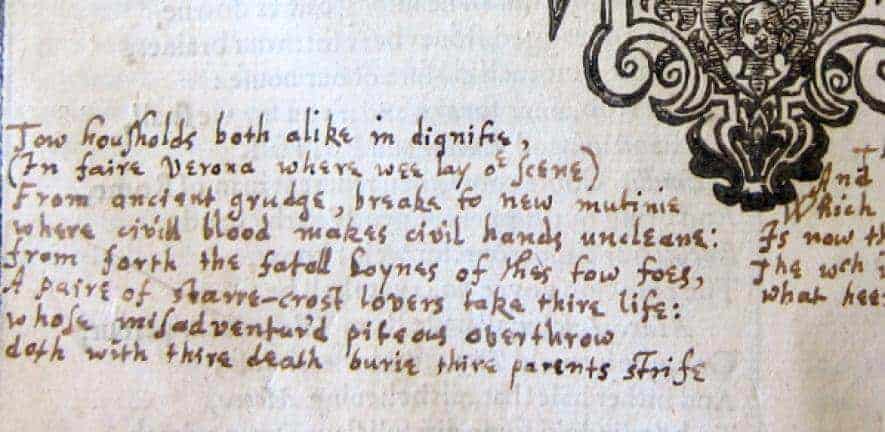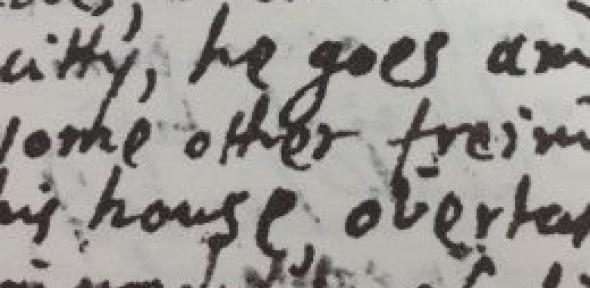It is well known that Shakespeare was a huge influence on Milton. From learning how to write nature poetry to creating charismatic villains, Milton’s debt to his forebear continues to fascinate experts. The younger poet once praised the ‘wonder and astonishment’ that this ‘great heir of fame’ conjured up in his readers.
But now, Jason Scott-Warren from Cambridge’s English Faculty believes he has identified even more tangible evidence of this connection. The realisation began when Scott-Warren read an article by Professor Claire Bourne about an anonymous annotator of a Shakespeare First Folio housed in the Free Library of Philadelphia’s Rare Book Department.
Bourne dated the annotator to the mid-17th century and shared images of the handwritten notes. These include suggested corrections, cross-references to other works and the addition of material such as the prologue to Romeo and Juliet. Studying these, Scott-Warren was struck by how closely they resembled known examples of Milton’s handwriting and after identifying numerous compelling similarities, he decided to share his theory in a blog post for Cambridge’s Centre for Material Texts, of which he is Director.
Milton is known to have made similarly intelligent and assiduous annotations in other books that survive from his library, but the evidence that Scott-Warren presents is strictly palaeographical. It includes the observation that in both the First Folio and in Milton’s handwriting, the right foot of an ‘h’ misses the ground before it heads up into an ‘e’.
Even more convincingly, Scott-Warren points out that “Milton has an enlarged italic hand, sometimes rather scratchy, sometimes quite elegant, that he uses for headings and suchlike.” The researcher compares, for example, the ‘R’ in the speech-heading for ‘Romeo’ in the Folio to a remarkably similar and distinctive ‘R’ from Milton’s ‘commonplace book’, a handwritten compilation of quotes and notes from the books that he was reading between the 1630s and 1660s.
Scott-Warren offered up his theory tentatively, admitting that further work would be needed to prove it beyond doubt. But several Milton experts from around the world have already expressed their enthusiastic support and offered further evidence.
Dr William Poole from New College Oxford says: “Not only does this hand look like Milton’s, but it behaves like Milton’s writing elsewhere does, doing exactly the things Milton does when he annotates books, and using exactly the same marks.”
“I was gathering evidence with my heart in my mouth,” Scott-Warren says. “Now, every day someone is suggesting a new similarity. I feel 100% sure, but there are still people out there who remain to be convinced.”
As well as displaying many textual annotations, the folio contains line markings which record the annotator’s lively engagement with plays including Hamlet, Romeo and Juliet, Macbeth, The Tempest and King Lear. Scott-Warren says: “You don’t know why he’s singled out a passage for attention, but it forces you to think your way into Milton’s head and it chimes with a lot of what goes on in his poetry. You can really see him constructing himself through Shakespeare.”
In The Tempest, the annotator highlighted the song: ‘Come unto these yellow sands, / And then take hands: / Courtsied when you have and kiss’d / The wild waves whist.’ The unusual rhyme, of ‘kiss’d’ and ‘whist’, is echoed in Milton’s On the Morning of Christ’s Nativity: ‘The winds with wonder whist, / Smoothly the waters kist.’
Scott-Warren says: “To see him marking it in the text and responding to it gives you a sense of his sensitivity and alertness to Shakespeare.”
The First Folio, the first collected edition of Shakespeare’s plays, was published in 1623, seven years after his death, when Milton himself was fifteen. Around 750 were printed but only 233 are known to survive. Scott-Warren is now intending to collaborate with Professor Bourne on a series of articles about the findings.
John Milton was admitted to Christ’s College Cambridge in 1624, gaining his BA in 1628 and his MA in 1632.



